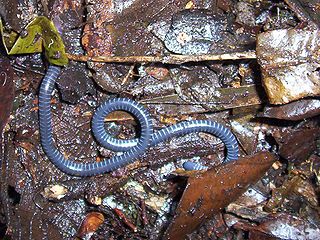
Caecilians are a group of limbless, vermiform or serpentine amphibians. They mostly live hidden in the ground and in stream substrates, making them the least familiar order of amphibians. All modern caecilians and their closest fossil relatives are grouped as a clade, Apoda, within the larger group Gymnophiona, which also includes more primitive extinct caecilian-like amphibians. Caecilians are mostly distributed in the tropics of South and Central America, Africa, and southern Asia. Their diet consists of small subterranean creatures such as earthworms.

Caeciliidae is the family of common caecilians. They are found in Central and South America. Like other caecilians, they superficially resemble worms or snakes.
Gegeneophis danieli, the Amboli caecilian or Daniel's caecilian, is a species of caecilians in the family Indotyphlidae. It was discovered from near Amboli in Western Ghats of Maharashtra.

The Western Ghats in India are home to several species of caecilians (Gymnophiona). Caecilians are legless, burrowing amphibians which mostly live in leaf litter, loose soil, under rocks and decaying logs. They are also found in agricultural fields and only surface during the monsoon. The body is elongated and smooth with a slimy skin. The smaller caecilians superficially resemble earthworms while the larger ones are often mistaken for snakes. However, they can be told apart from earthworms by the presence of eyes, teeth and skeleton and from snakes by the lack of scales on skin. The eyes in caecilians are not well developed which is most likely to be because of their burrowing life style. They are considered as rare which is apparently due to their subterranean habits. To see them one has to search carefully and be at the right place and at the right time. There are few places where they are common, but, at least one species was reported to be abundant in agricultural fields in Kerala. The larger caecilians can resemble snakes, but their skin is smooth, not scaly.

Boulengerula is a genus of amphibians in the family Herpelidae. They are found in East Africa. They are sometimes known as Boulenger's caecilians or Usambara bluish-gray caecilians.
Caecilia thompsoni, commonly called Thompson's caecilian, is a species of caecilian in the family Caeciliidae. It is endemic to Colombia. It is the largest of the worm-like caecilians and reaches a length of 1.5 m (5 ft) and can weigh up to about 1 kg (2.2 lb). Its natural habitats are subtropical or tropical moist lowland forest, subtropical or tropical moist montane forest, plantations, rural gardens, and heavily degraded former forest.
Dermophis occidentalis is a species of caecilian in the family Dermophiidae. It is endemic to south-western Costa Rica and occurs in the Pacific lowlands and premontane slopes, extending to the western part of the central valley. Its taxonomic status is unclear.
Geotrypetes is a genus of caecilians in the family Dermophiidae, although some classifications place it in the family Caeciliidae. They occur in tropical West Africa and are sometimes known as the West African caecilians.

Oscaecilia bassleri, or Bassler's slender caecilian, is a species of caecilian in the family Caeciliidae. It is found in Ecuador, Peru, possibly Bolivia, and possibly Colombia. Its natural habitats are subtropical or tropical moist lowland forests, plantations, rural gardens, and heavily degraded former forest.
Oscaecilia elongata is a species of caecilian in the family Caeciliidae. It is endemic to Panama. Its natural habitats are subtropical or tropical moist lowland forests, plantations, rural gardens, and heavily degraded former forest.
Oscaecilia equatorialis is a species of caecilian in the family Caeciliidae. It is endemic to Ecuador. Its natural habitats are subtropical or tropical moist lowland forests, plantations, rural gardens, and heavily degraded former forest.

Oscaecilia hypereumeces is a species of caecilian in the family Caeciliidae. It appears to be endemic to Brazil and is only known from two specimens. The holotype was collected from Joinville in Santa Catarina, although there are some doubts whether this really is its correct origin. Another specimen originates from an unknown locality. Common name Joinville caecilian has been proposed for this species.
Oscaecilia koepckeorum is a species of caecilian in the family Caeciliidae. It is endemic to Peru. Its natural habitats are subtropical or tropical moist lowland forests, plantations, rural gardens, and heavily degraded former forest.

Oscaecilia ochrocephala is a species of caecilian in the family Caeciliidae. It is found in Colombia and Panama. Its natural habitats are subtropical or tropical moist lowland forests, plantations, rural gardens, and heavily degraded former forest.
Oscaecilia osae is a species of caecilian in the family Caeciliidae. It is endemic to Costa Rica and is only known from the Golfo Dulce area, on the Pacific Ocean side of Costa Rica. The specific name osae refers to its type locality, the airstrip at La Sirena, being located on the Osa Peninsula. It is also known as the airstrip caecilia or airstrip caecilian.
Oscaecilia polyzona is a species of amphibian in the family Caeciliidae. It is found in Colombia and possibly Panama. Its natural habitats are subtropical or tropical moist lowland forests, plantations, rural gardens and heavily degraded former forest.
Oscaecilia zweifeli is a species of caecilian in the family Caeciliidae. It is a poorly known species only known from few specimens: the holotype from the imprecise type locality, "a small creek tributary to Río Mazaruni" in Guyana, one from similarly imprecise Cayenne in French Guiana, and another one from the Nouragues research station in French Guiana. The specific name zweifeli honors Richard G. Zweifel, an American herpetologist. Common names Zweifel's caecilian and tributary caecilian have been coined for it.
Gegeneophis is a genus of amphibians in the family Indotyphlidae. They are found in southern and northeastern India.
Indotyphlus is a small genus of caecilians in the family Indotyphlidae. As caecilians in general, they superficially resemble earthworms. The genus is endemic to the Western Ghats, India. They are sometimes known as Battersby's caecilians.






